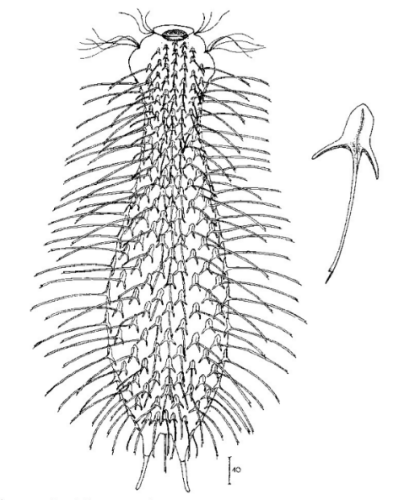(Hystricochaetonotus)

- Body length 60 - 190 µm
- three-lobed scales with axial keel
- spine with secondary tip (but can sometimes be absent or double)
- all scales spiny, spines elongate from front to back
For the subgenus Hystricochaetonotus are the relatively large, non-overlapping scales with a long spine. This subgenus owes its name to this spiny appearance (hystix = porcupine).
 *Typical Chaetonotus (Hystricochaetonotus) - here
C. (H. ) persetosus
*Typical Chaetonotus (Hystricochaetonotus) - here
C. (H. ) persetosus
The scales are in typical arrangement. Their shape is trilobate with a central keel, at the end of which arises a long spine - usually with a secondary tip:

typical three-lobed scales in Hystricochaetonotus - here
C. (H. ) persetosus
46 Species:

Chaetonotus (H. ) longispinosus

Chaetonotus (H. ) lucksi

Chaetonotus (H. ) luxus

Chaetonotus (H. ) machikanensis

Chaetonotus (H. ) macrochaetus

Chaetonotus (H. ) mirabilis

Chaetonotus (H. ) murrayi
159 µm - 160 µmVentral scales: 2 long, thin terminal plates with short spines; 7-8 rows of small keel scales (1µm - 3µm)
Particularities: Toes naked; rigidly protruding spines are very typical

Chaetonotus (H. ) novenarius
106 µm - 193 µmDorsal scales: 7 rows on the head, 12 on the trunk, each with 14-15 three-lobed, keeled scales (3-6 µm), which do not overlap and are short and delicately spined (10 µm); two rows of longer spines at the head end. Very long spines with two secondary tips (26-50 µm) in a relatively narrow field on the anterior trunk
Ventral scales: 2 elongate-oval, keeled terminal plates (6.6µm x 4µm) with two simple spines; 4-6 rows with 40 oval keel scales each. Own observation: in pharyngeal region rectangular transverse claspers
Particularities: easily delimited by the long spines that emerge from a narrow field

Chaetonotus (H. ) octonarius
